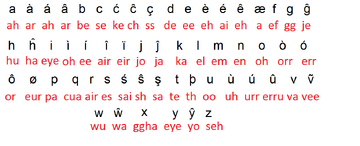| Progress 80% | ||||||||||||||||||||||||||||||||||||||||||||||||||||||||||||||||||||||||||||||||||||||||||||||||||||||
|
| ||||||||||||||||||||||||||||||||||||||||||||||||||||||||||||||||||||||||||||||||||||||||||||||||||||||
|
||||||||||||||||||||||||||||||||||||||||||||||||||||||||||||||||||||||||||||||||||||||||||||||||||||||
| [[]] ' | |||
|---|---|---|---|
| Type | |||
| Alignment | |||
| Head direction | |||
| Tonal | |||
| No | |||
| Declensions | |||
| No | |||
| Conjugations | |||
| Yes | |||
| Genders | |||
| No | |||
| Nouns decline according to... | |||
| Case | Number | ||
| Definiteness | Gender | ||
| Verbs conjugate according to... | |||
| Voice | Mood | ||
| Person | Number | ||
| Tense | Aspect | ||
General information[]
Worslandic is a Germanic Language; that comes from English. Its spoken in Northern England, in the Yorkshire and Lancashire Areas.
Flag[]
General[]
| Gender | Cases | Numbers | Tenses | Persons | Moods | Voices | Aspects | |
|---|---|---|---|---|---|---|---|---|
| Verb | Yes | No | No | Yes | No | No | No | No |
| Nouns | Yes | No | No | No | No | No | No | No |
| Adjectives | Yes | No | No | No | No | No | No | No |
| Numbers | Yes | Yes | No | No | No | No | No | No |
| Participles | No | No | No | Yes | No | No | No | No |
| Adverb | No | No | No | Yes | No | No | No | No |
| Pronouns | Yes | No | Yes | No | Yes | No | No | No |
| Adpositions | Yes | No | No | No | No | No | No | No |
| Article | Yes | Yes | No | No | Yes | No | No | No |
| Particle | No | No | No | No | No | Yes | No | No |
Alphabet[]

Worslandic Alphabet Aþàrbegt de Wørslandsk
http://en.wikipedia.org/wiki/International_Phonetic_Alphabet
Phonotactics[]
Articles and Nouns[]
In Worslandic, there are 2 genders 'Masculine and Feminine'.
Masculine nouns use 'Un' for 'A'.
Feminine nouns use 'Um' for 'A'.
We will take the two nouns Tree (Trig) and Cat (Gjat).
| Singular | Plural | |
|---|---|---|
| Masculine | Un Trig | Trigos |
| Feminine | Um Gjat | Gjatas |
Masculine and Feminine nouns both use 'Hje' for 'The'.
We will take the two nouns Tree (Trig) and Cat (Gjat).
| Singular | Plural | |
|---|---|---|
| Masculine | Hjo Trig | Hjos Trigos |
| Feminine | Hja Gjat | Hjas Gjatas |
The Article 'The' conjugates depending on gender. Here is the table.
| Singular Masculine | Singular Feminine | Plural Masculine | Plural Feminine | |
|---|---|---|---|---|
| A (Some) | Un | Um | Djos | Djas |
| The | Hjo | Hja | Hjos | Hjas |
Numbers[]
1 - Umo (umo)
2 - Djes (days)
3 - Trés (trrays)
4 - Ĉuatrá (cuatrra)
5 - Ĉïnqá (chinka)
6 - Séi (sei)
7 - Syṽen (see-vein)
8 - Eucht (ookt)
9 - Néu (new)
10 - Zéi (tz-ei)
Verbs[]
(Fact: All verbs in Worslandic end in je)
Here is a list of the main Irregular verbs:-
Þje - To Be
Aje - To Have
Maje - To Eat
Bevje - To Drink
Ṽaje - To go
Faje - To do/make
Villje - To want
Géetje - To get
To Be - Þje[]
I am - Eć e
You are - Þe es
He/She is - Ilò/Ilà est
We are - Wiò etiò
You are - Þiò etiò
They are - Ilòs/Ilàs etiòs
To Have - Aje[]
I have - Eć a
You have - Þe as
He/She has - Ilò/Ilà ast
We have - Wiò aviò
You have - Þiò aviò
They have - Ilòs/Ilàs aviòs
To Go - Ṽaje[]
I go - Eć ṽa
You go - Þe ṽas
He/She goes - Ilò/Ilà ṽa
We go - Wiò ṽaiò
You go - Þiò ṽaiò
They go - Ilòs/Ilàs ṽaiòs
To find the stem of a verb, you simply remove the je ending.
Present Tense[]
To form the Present Tense, you remove the je ending and add the following endings shown in the table below. We will use the verb 'To swim' Narje as our example:
| Person | Pronoun | Verb Ending |
|---|---|---|
| 1st singular (I) | Eć | Nare |
| 2nd singular (You) | Þe | Nares |
| 3rd singular (He/She) | Ilò/Ilà | Narest |
| 1st plural (We) | Wiò | Nariò |
| 2nd plural (You) | Þiò | Nariò |
| 3rd plural (They) | Ilòs/Ilàs | Nariòs |
The present tense is used to talk about what we do/are doing.
Here are the following translations for the sentences:
I sit on the chair.
Eć zyte pi hjo ĉér.
I eat my breakfast every day.
Eć ette mja pauseþaĉhe evrydag.
Imperfeita Tense[]
To form the Imperfect Tense, you remove the je ending and add the following endings shown in the table below. We will use the verb 'To swim' Narje as our example:
| Person | Pronoun | Verb Ending |
|---|---|---|
| 1st singular (I) | Eć | Naráis |
| 2nd singular (You) | Þe | Naráis |
| 3rd singular (He/She) | Ilò/Ilà | Naráit |
| 1st plural (We) | Wiò | Naraìo |
| 2nd plural (You) | Þiò | Naraìo |
| 3rd plural (They) | Ilòs/Ilàs | Naraìo/aìa |
The Imperfect Tense is used to talk about what we used to do or what we did.
I described the woman. Eć dyskribáis hja fréu.
Syntax[]
Vocabulary[]
Worslandic Dictionary

